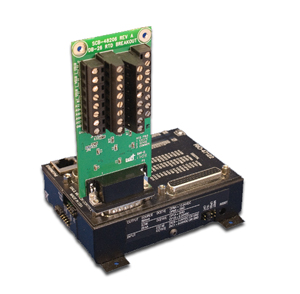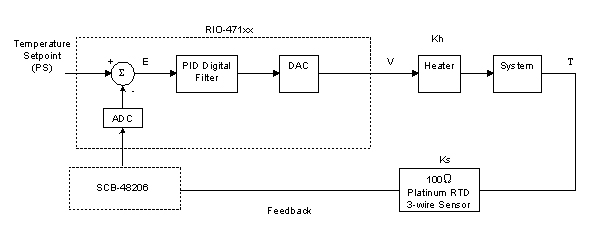Galil’s RIO Pocket PLC and new SCB interface for RTDs and thermocouples provide an easy method for precisely handling temperature control applications. The SCB-48206 Signal Conditioning Board interfaces to up to six RTDs (Resistive Temperature Device) and the SCB-483x6 provides interface for up to six thermocouples. The SCB-48xx6 boards can connect directly to the 26-pin d-sub connector of the RIO-47120/47122 or can be mounted remotely via a 26pin cable.
The SCB-48316 (shown above) has thermocouple mating connectors. The SCB-48306 has screw terminal connectors.
RTD Measurement
An RTD is a Resistive Temperature Device that takes advantage of the fact that a material’s resistance changes as a function of temperature. Most RTD elements consist of a fine coiled wire wrapped around a ceramic or glass core. The RTD element is made from a pure material whose resistance at different temperatures is known. Since the material used has a predictable change in resistance based on temperature – this is used to accurately measure temperature. Typical materials used for RTD’s include: Platinum (most common), Nickel, Copper, Balco, or Tungsten.
Some benefits of RTDs are:
•Wide temperature range
•Good Accuracy (better than Thermocouples)
•Repeatability and resistance to electrical noise
•Long-Term stability (ie: aging)
RTDs are positive temperature coefficient (PTC) sensors which mean their resistance increases with temperature.
Thermocouple Measurement
A thermocouple is based on the “thermoelectric effect” which occurs when two different metals are connected together – a voltage is produced that is dependant on the type of metals used and the temperature. In order for the thermal voltage to produce a current, the metals must be connected together at both ends so that a closed circuit is formed. If the temperature is the same at both ends, there is no flow of current. Thus, a thermocouple can only measure temperature differences. For this reason, the reference junction temperature must be known for an accurate measurement to occur. Since the reference temperature point is generally lower than the measured temperature – it is generally called the cold junction. At the “cold junction” or reference junction, an RTD or similar temperature sensor is used to have an accurate reference temperature. The voltage produced by a thermocouple is very small and amounts to only a few microvolts per degree Celsius. Thermocouples are generally not used in applications in the range of -30 to 50°C because the difference between the reference temperature and the measurement temperature is too small to get accurate noise-free signals. However, compared with other sensors – thermocouples offer an advantage of a higher upper temperature limit and are therefore frequently used to measure temperatures in ovens, furnaces, etc.
Example Applications
Consider an HVAC application where a heating and air conditioning unit needs to be run in order to precisely control the temperature of a room. The block diagram of this setup would look something like this when in the “heating” mode:
In this case a set-point is commanded by an external source and the RIO uses the internal PID filter to close the loop around the 100Ohm RTD. An analog output from the RIO controls the heater such that when the temperature of the room lowers, an error is created between the set-point and the actual temperature measured by the RTD. This error goes through the PID filter and increases the RIO voltage to the heater to raise the temperature of the room. This cycle continues repeatedly to keep the room at the desired set-point.
At $175 in single quantity and $125 in 100 quantities, the SCB-48x06 provides a cost-effective interface to RTDs and thermocouples. Galil's RIO Pocket PLC series is smart, compact, low cost and packed with I/O. Standard features include analog and digital I/O, Ethernet and RS232 ports, RISC processor for fast I/O handling, PID process control loops, counters, timers, data logging, ability to send email alerts, Power-over-Ethernet, and more. Visit http://www.galil.com/plcs to download complete specifications and view an on-line video about the RIO.




